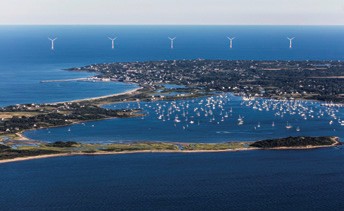By Amanda Yanchury and Megan Herzog, Conservation Law Foundation
Momentum in clean, renewable energy
 Last year, the first offshore wind farm in the United States began producing power in the waters just off of Rhode Island in a historic moment for New England and for the country. Deepwater Wind’s 30-megawatt, five-turbine farm now powers more than 17,000 Rhode Island homes.
Last year, the first offshore wind farm in the United States began producing power in the waters just off of Rhode Island in a historic moment for New England and for the country. Deepwater Wind’s 30-megawatt, five-turbine farm now powers more than 17,000 Rhode Island homes.
Deepwater Wind’s Block Island Wind Farm is generating electricity for more than 17,000 homes in the Ocean State. ©seagrant.gso.uri.edu
Many years in the making, the success of this project is the start of a new chapter for the health of our environment, economy, and for all of us. As rising seas, intensifying storms, and climbing temperatures threaten our coasts, marine life, and communities, cutting fossil fuel emissions and investing in renewable energy sources is critical and urgent in the fight against climate change
And as demand for offshore wind soars, a key lesson from this first success is that good stewardship of the environment is also good business. Throughout the Block Island project, developers engaged key stakeholders in the process in order to minimize impacts to endangered North Atlantic right whales and other ocean resources while building its wind farm on time and on budget.
The Important Role of Ocean Planning
Here in New England, finding a balance between the natural environment and human activities is incredibly important. Our waters are home to endangered species as well as critical habitats and mistakes in the environmental planning process can have serious consequences. For example, the areas surrounding Cape Cod are essential feeding grounds for the endangered North Atlantic right whale. This species makes the waters off Cape Cod its home for many months of the year as it makes its annual migration from warmer waters down south. During the spring and summer of 2017, a dozen of these whales perished in Canada’s Gulf of Lawrence – likely due to fishing gear entanglement and ship strikes. A dozen may not sound like much, but it’s a significant portion of the population: only about 500 of these whales remain.
This is incredibly alarming, so it’s important that all human activities are mindful of these endangered whales. When the Block Island wind project was in its planning stages, we at CLF worked together with other NGOs and the developers to ensure that right whales wouldn’t be harmed during the wind farm’s pre-construction activities. This type of coordination is an extremely vital step in any offshore wind project.
The mapping of right whale migration routes, essential habitat boundaries for these whales, and the creation of ship guidelines are all essential tools to avoid harming sensitive marine life. Fortunately, all of this data is available for anyone to obtain from the Northeast Data Portal, a key component of our region’s new Northeast Ocean Plan.
The Northeast Ocean Plan, which guides the management of ocean resources across the region, was approved in 2016 and began its implementation phase in 2017. We’re keeping an eye on how offshore wind developers (and other types of energy developers) choose to use the data available to them in new projects to ensure that the dual priorities of environmental health and renewable energy can coexist.
Next up: Progress in Massachusetts
A 2016 Massachusetts energy law required the state’s biggest utilities to buy offshore wind power, ensuring that the Block Island project was just the beginning for this up-and-coming industry.
As a result of the law, Massachusetts’ three biggest electric companies issued a groundbreaking request for offshore wind energy bids last June. Wind developers are now competing to sell Massachusetts residents at least 400 megawatts (and up to a whopping 800 megawatts) of offshore wind power – enough to power up to a quarter million homes and businesses.
We’re closely following the bidding and will advocate for a project that nurtures Massachusetts’ nascent wind industry, protects valuable ocean and coastal resources like the endangered North Atlantic right whale, and ensures our transition to a clean energy economy.
Other states are picking up speed, too. New York and Maryland are moving ahead with their own offshore wind projects, Rhode Island is hungry for more and Connecticut has expressed interest in joining future bid requests.
New England’s leadership has already kick-started a new era of offshore wind. CLF will be here to see it through and ensure that Rhode Island’s and Massachusetts’ projects are just the beginning of a sustained and vibrant offshore wind industry that generates continual and growing benefits for everyone.
Clean, renewable energy – that prioritizes marine life and the environment – is no longer simply a vision for our future. It’s our here and now, and it’s here to stay.
This Sailors for the Sea Ocean Watch Essay is reprinted with permission. To learn more, log onto sailorsforthesea.org.




